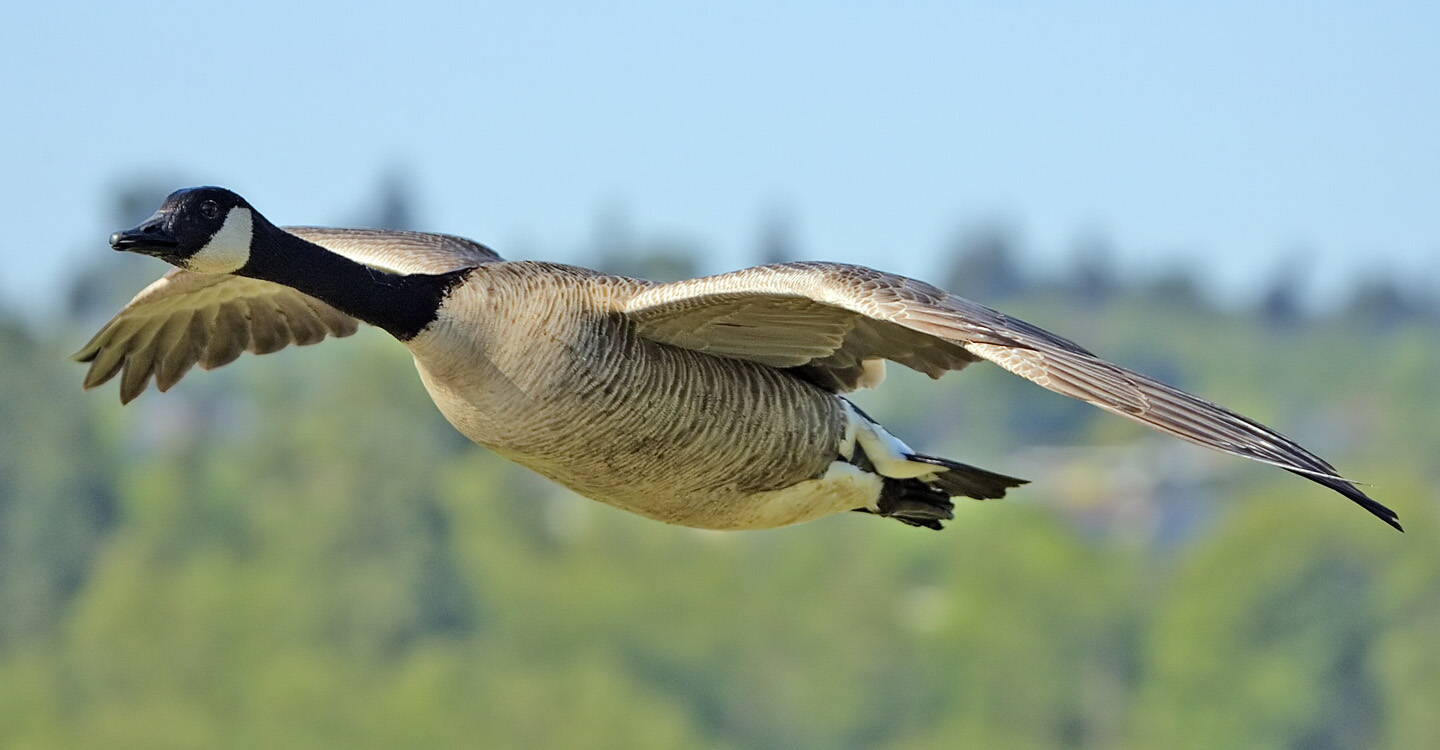- Goose
image_width = 240px
image_caption =Canada Goose , "Branta canadensis"
regnum =Animal ia
phylum =Chordata
classis =Aves
superordo =Galloanserae
ordo =Anseriformes
familia =Anatidae
subfamilia =Anserinae
tribus = Anserini
tribus_authority =
subdivision_ranks =Genera
subdivision ="Anser" "Branta " and see textGoose (plural: geese) is the English name for a considerable number of
bird s, belonging to the familyAnatidae . This family also includesswan s, most of which are larger than geese, andduck s, which are smaller.This article deals with the true geese in the
subfamily Anserinae , tribe Anserini.A number of other waterbirds, mainly related to the
shelduck s, have "goose" as part of their name.Description
True geese are medium to large birds, always (with the exception of the Nēnē) associated to a greater or lesser extent with water. Most species in
Europe ,Asia , andNorth America are strongly migratory as wild birds, breeding in the far north and wintering much farther south. However, escapes and introductions have led to resident feral populations of several species.Geese have been
domesticated for thousands of years. In the West, farmyard geese are descended from the Greylag, but in Asia theSwan Goose has been farmed for at least as long.All geese eat a vegetarian diet, and can become pests when flocks feed on arable crops or inhabit ponds or grassy areas in urban environments. They also take
invertebrate s if the opportunity presents itself; domestic geese will try out most novel food items for edibility. Geese usually mate for life, though a small number will "divorce" and remate. They tend to lay a smaller number of eggs than ducks but both parents protect the nest and young, which usually results in a higher survival rate for the young geese.Not all couples are heterosexual, as both females and males will form long-term same-sex couples with greater or lesser frequency depending on species. [Bagemihl (1999): pp.479-481. More detailed data exists for
Greylag Goose ,Canada Goose , andSnow Goose .] Of the homosexual couples, a significant proportion are non-breeding despite having an active sexual life.Etymology
"Goose" in its origins is one of the oldest words of the
Indo-European language s (Crystal), the modern names deriving from the proto-Indo-European root, "ghans", henceSanskrit "hamsa" (feminine "hamsii"), Latin "anser", Greek "khén" etc.In the
Germanic language s, the root word led to Old English "gos" with the plural "gés", German "Gans" and Old Norse "gas". Other modern derivatives are Russian "gus" and Old Irish "géiss"; the family name of the clericJan Hus is derived from the Czech derivative "husa".The male goose is called a gander (Anglo-Saxon "gandra") and the female is the goose ("Webster's Revised Unabridged Dictionary (1913)"); young birds before fledging are known as goslings. A group of geese on the ground is called a gaggle; when flying in formation, it is called a wedge or a skein (see also
list of collective nouns for birds ).True geese
The following are the living genera of true geese:
* "Anser" - Grey Geese, including thedomesticated goose and theSwan Goose
* "Chen" - White Geese (often included in "Anser")
* "Branta " - Black Geese, such as theCanada goose The following two genera are only tentatively placed in the Anserinae; they may belong to the
shelduck s or form a subfamily on their own:
* "Cereopsis " - Cape Barren Goose
* "Cnemiornis" - New Zealand Geese (prehistoric)Either these or - more probably - the goose-like
Coscoroba Swan is the closest living relative of the true geese.Fossil s of true geese are hard to assign to genus; all that can be said is that their fossil record, particularly inNorth America , is dense and comprehensively documents a lot of the different species of true geese that have been around since about 10million years ago in theMiocene . The aptly-named "Anser atavus" ("Great-great-great-grandfather goose") from some 12 million years ago had even moreplesiomorph ies in common with swans. In addition, there are some goose-like birds known fromsubfossil remains found on theHawaiian Islands . SeeAnserinae for more.Other birds called "geese"
There are a number of mainly
southern hemisphere birds called "geese", most of which belong to theshelduck subfamilyTadorninae . These are:
*Orinoco Goose , "Neochen jubata"
*Egyptian Goose , "Alopochen aegyptiacus"
* The South American sheldgeese, genus "Chloephaga"
* The prehistoricMadagascar Sheldgoose , "Centrornis majori", the "Woodard"Verify source|date=January 2008Fact|date=January 2008The
Blue-winged Goose , "Cyanochen cyanopterus" belongs either to these, or to lineage closer to ducks.The
Spur-winged Goose , "Plectropterus gambensis", is most closely related to the shelducks, but distinct enough to warrant its own subfamily, thePlectropterinae .The three species of small waterfowl in the genus "
Nettapus " are named "pygmy geese", e.g. theCotton Pygmy Goose ("N. javanica"). They seem to represent an ancient lineage like the Cape Barren Goose and the Spur-winged Goose.A genus of prehistorically
extinct seaduck s, "Chendytes ", is sometimes called "diving-geese" due to their large size.The unusual
Magpie-goose is in a family of its own, the Anseranatidae.The
Northern Gannet , a seabird, is also known as the "Solan Goose" although it is a bird unrelated to the true geese, or any otherAnseriformes for that matter.See also
*
Angel Wing - A disease common in geese.
*Domesticated goose , which includes cooking and folklore
*List of goose breeds
*Waterfowl
*Wildfowl References
* (1999): "Biological Exuberance: Animal Homosexuality and Natural Diversity". St. Martin's Press. ISBN 0-312-19239-8
* (1992): Family Anatidae (Ducks, Geese and Swans). "In:" aut|del Hoyo, Josep; Elliott, Andrew & Sargatal, Jordi (eds.): "Handbook of Birds of the World " (Volume 1: Ostrich to Ducks): 536-629, plates 40-50. Lynx Edicions, Barcelona. ISBN 84-87334-10-5
* (1998): "The Cambridge Encyclopedia of Language" (Paperback) ISBN 0-521-55967-7
* (1991): "The Audubon Society Encyclopedia of North American Birds". Wings Books, New York. Reprint of 1980 edition. ISBN 0-517-03288-0External links
* [http://ibc.hbw.com/ibc/phtml/familia.phtml?idFamilia=27 Goose videos] on the Internet Bird Collection
Wikimedia Foundation. 2010.

